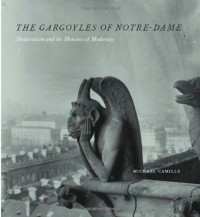Bettie's Books
A Stuga On the Cusp of the Orust Riviera, tucked away next to a hobbit hole in the woods.
The Gargoyles of Notre-Dame: Medievalism and the Monsters of Modernity

bookshelves: published-2007, summer-2013, e-book, under-20, nonfiction, paris, france, art-forms, architecture, history, medieval5c-16c, reference-book, cults-societies-brotherhoods, ghosties-ghoulies, gothic, anti-semitic, mythology, philosophy, racism

Opening: There are many churches dedicated to Notre Dame but only one Notre-Dame de Paris. Located on the east end of the Île-de-la-Cité, the cathedral is the spiritual and geographic center not only of Paris, but of the whole of France. Built between 1163 and 1250, it remains one of the first and most innovative Gothic structures in Europe. Le Stryge: the unique and the single most memorable creation of the nineteenth-century restorer and architectural theorist Viollet-le-Duc. Though not a gargoyle in the proper sense of the term (since he does not serve as a drainpipe) he has nonetheless become the very essence of gargoyleness, the quintessence of the modern idea of the medieval.
Le Stryge: the unique and the single most memorable creation of the nineteenth-century restorer and architectural theorist Viollet-le-Duc. Though not a gargoyle in the proper sense of the term (since he does not serve as a drainpipe) he has nonetheless become the very essence of gargoyleness, the quintessence of the modern idea of the medieval. Charles Méryon Le Stryge.
Charles Méryon Le Stryge.
Gargoyles remove 'all the body, filth, and foulness that is ejected from the edifice'
'Romanesque architecture died. . . . From now on, the cathedral itself, formerly so dogmatic an edifice, was invaded by the bourgeoisie, by the commons, by liberty; it escaped from the priest and came under the sway of the artist. The artist built to his own fancy. Farewell mystery, myth and law. Now it was fantasy and caprice. . . . The book of architecture no longer belonged to the priesthood, to religion and to Rome; it belonged to the imagination, to poetry and to the people. . . . Now architects took unimaginable liberties, even towards the Church. Monks and nuns coupled shamefully on capitals, as
in the Hall of Chimneys in the Palais de Justice in Paris. The story of Noah was carved in full, as beneath the great portal of Bourges. A bacchic monk with asses’ ears and glass in hand laughed a whole community to scorn, as above the lavabo in the Abbey of Boscherville. At that time, the thought that was inscribed in stone enjoyed a pivilege entirely comparable to our present freedom of the press. This was the freedom of architecture.' Victor Hugo
 5
5


